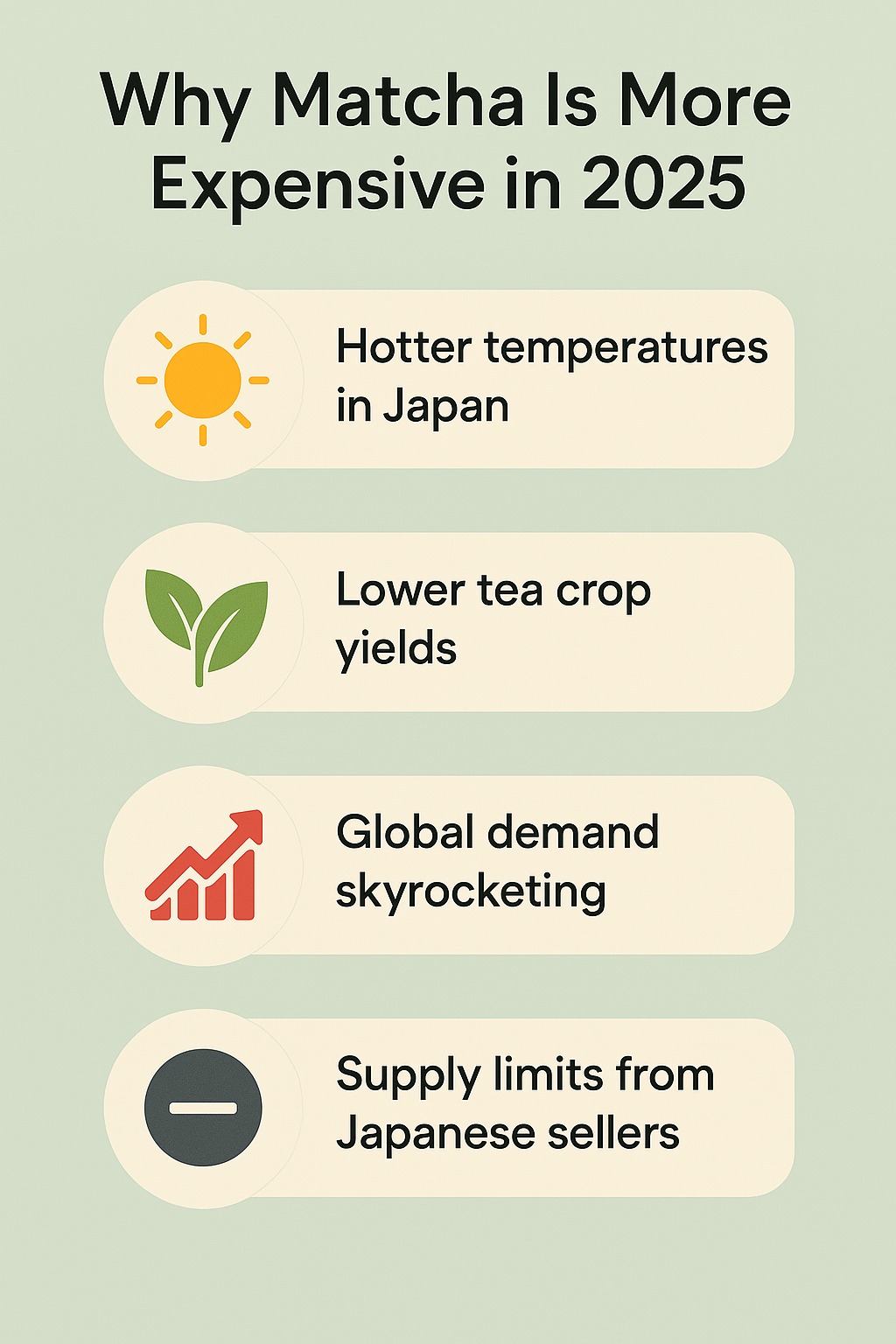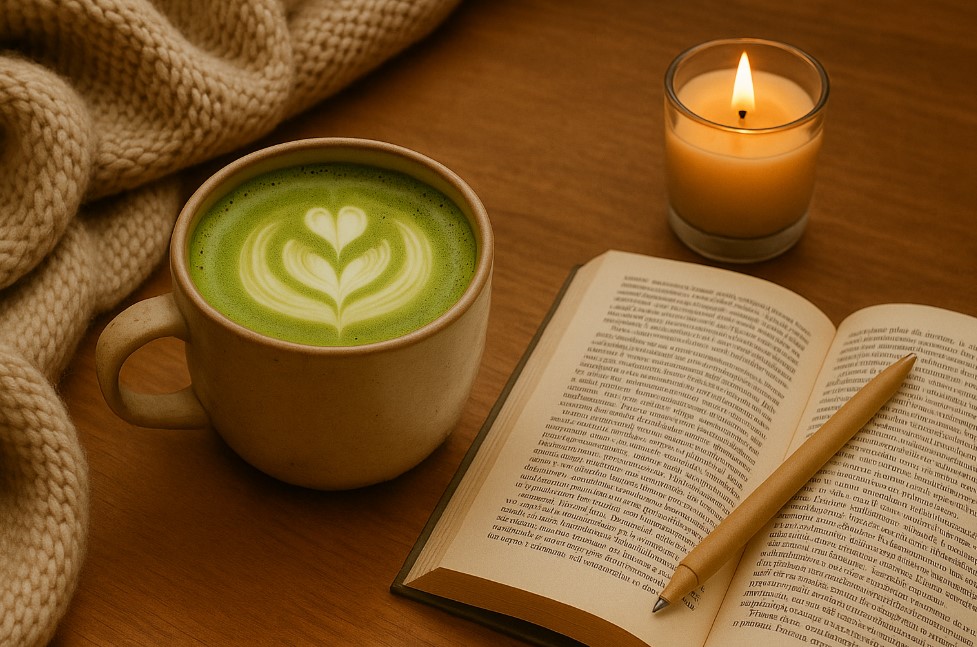
If your favorite tin of matcha now costs more than a decent brunch, you’re not hallucinating—just living through the Great Green Tea Squeeze of 2025. Matcha prices are spiking, supplies are thinning, and even your basic grocery store blend is acting like it’s too good for us now.
So what’s really going on behind the price hike? Is the matcha shortage just another social media-driven panic, or is there something deeper at play in the tea world? Let’s unpack the storm brewing in your teacup, explore how to find high-quality matcha without auctioning off your kidney, and offer a few delicious alternatives if you’re feeling matcha-fatigued.
What’s Going On With Matcha in 2025?
Climate change is hitting Japan’s matcha farms hard. Key regions like Kyoto’s Uji and Kagoshima have faced extreme heat waves, frosts, and erratic rainfall, damaging the shade-grown tencha leaves used for matcha. In 2025, yields dropped by up to 25%, especially for higher-grade leaves.
Ceremonial-grade matcha needs precise growing conditions—shade, timing, and careful milling—which climate swings now disrupt. At the same time, matcha demand has exploded thanks to TikTok, Instagram, and Gen Z’s obsession with natural, energizing drinks. What was once niche is now everywhere.
Suppliers can’t keep up. Some Japanese farms are rationing orders or pausing international shipping, while shops in Singapore and Australia limit purchases to stop hoarding. The shortage is hitting everyone—from cafés to grocery shelves.
For more detailed information on the impact of climate change on matcha production and the global supply shortage, see Reuters’ coverage on the topic.
Why Is Matcha So Expensive Right Now?
Prices for ceremonial-grade matcha have spiked by as much as 170–180% this year alone. While part of this is due to actual scarcity, it’s also driven by logistics challenges, increased labor costs, and (let’s be honest) a bit of opportunistic marketing. Some retailers are rebranding mid-range matcha as “luxury wellness elixirs,” and the pricing reflects that.
What makes ceremonial matcha pricey to begin with? It comes down to:
- Labor-intensive farming: Shading the tea leaves for weeks before harvest increases amino acid content but requires specialized infrastructure.
- Limited harvest windows: Top-tier matcha comes from the first flush of the season, which is already a small yield.
- Stone milling: Traditional grinding methods are slow and expensive but essential for that smooth, silky texture.
- Freshness requirements: Matcha degrades quickly, so packaging, storage, and transport all need to be top-notch.
And while you can still find matcha at lower prices, it’s often older stock, culinary grade passed off as ceremonial, or blends padded with other green teas. That doesn’t mean you have to settle—you just have to shop smarter.

So… Where Can You Still Get Good Matcha Without Auctioning Off a Kidney?
Breathe. You’ve got options. Here’s where to look:
Ito En Unsweetened Matcha Powder (40g/1,4 oz)
A staple for a reason. While it’s technically culinary-grade, this matcha delivers vibrant green color and a balanced, grassy flavor that works beautifully in lattes and smoothies.
On Amazon, the 40 g (1.4 oz) tin is currently listed for about $11.99, which breaks down to roughly $6.00 per ounce, and it’s rated around 4.5 stars from over 1,300 reviews
Lovely Tip: This is my go-to for “I need caffeine and have no will to be fancy” mornings.
Ocha & Co. Japanese Matcha Powder (/100g3,5 oz )
Smooth, fresh, and slightly creamy, this matcha is small-batch packed in Japan and ideal for sipping or baking. It strikes a “premium-but-practical” note—clean enough to whisk, robust enough to latte.
You can currently grab a 100g pouch on Amazon for around $30.95, or $27.85 if you use Subscribe & Save. That breaks down to about $7.96 per ounce, which is excellent value for the quality.
With a 4.4-star rating from over 850 reviewers, it’s a crowd favorite for its balanced umami, vibrant green color, and smooth finish.
Bonus: It’s certified organic, ships quickly, and the minimalist packaging won’t ruin your shelf aesthetic
Jade Leaf Matcha Organic Green Tea Powder (250g /8.8 oz)
For the ride-or-die matcha lovers. If you go through a tin a week or you’re a matcha-chia-pudding evangelist, bulk is your budget BFF.
This USDA organic, culinary-grade matcha delivers reliable flavor—perfect for smoothies, energy bites, or your fifth oat milk latte of the day. On Amazon, the 250g (8.8 oz) bag is currently listed for around $39.95, which breaks down to about $4.54 per ounce—a serious value compared to smaller tins.
With nearly 100,000 reviews and a 4.5-star rating, it’s a fan favorite for daily use. The flavor is mellow, the color holds up, and it blends smoothly whether you’re whisking or blending.
Pro tip: Once opened, transfer to an airtight container and refrigerate. Matcha hates light, heat, and commitment.
Want to Get Fancy? Consider a Starter Kit
Whether you’re gifting or just want to level up your own experience, these sets help enhance your ritual:
- Bamboo Whisk + Scoop Set – for the purists
- Modern Matcha Electric Frother Set – for the techy tea crowd

Smart Matcha Moves to Make Right Now
Here’s how to stretch your stash—and your budget—while the market’s acting spicy.
1. Buy Small Batches, More Often
Matcha loses its vibrant green color and sweet umami flavor fast—especially if you’re storing it like it’s paprika. Stick to 30–40g tins and resist the Costco-size tubs unless you’re hosting daily tea ceremonies.
2. Store It Like You Mean It
Air, heat, and light are matcha’s mortal enemies. Once opened, keep it:
- In an airtight tin or resealable pouch
- Away from sunlight
- In the fridge (but make sure it’s sealed tightly so it doesn’t absorb other flavors— No one wants garlic scented tea.
For a full deep dive on how to keep your green tea fresh and flavorful, check out my detailed guide here: The Ultimate Guide to Storing Green Tea.
3. Use the Right Grade for the Job
Ceremonial is ideal for whisked tea. But if you’re making lattes, smoothies, or baked goods, use culinary-grade—it’s designed to hold up to milk and heat. Don’t waste your $40 powder on muffins. Your tastebuds won’t know the difference.
Tired of Matcha? Try These Flavorful (and Cheaper) Alternatives
Even the most devoted matcha lovers need a change. If you’re looking to give your wallet (or palate) a break, consider:
Nutty, mellow, and incredibly affordable. It’s made from tea stems and has a naturally low caffeine content—great for afternoon sipping or late-night Netflix sessions.
Like sencha but smoother and more umami-rich, thanks to its partial shading before harvest. Not quite matcha-level indulgence, but close.
A roasted green tea with a toasty, cozy flavor and almost no bitterness. It’s caffeine-light and pairs beautifully with oat milk.
Pro move: Use hōjicha powder as a matcha substitute in lattes. Same froth, different vibe.
Final Thoughts (And One Long, Deep Breath)
So yes—matcha is having a dramatic year. Climate change is real, hype is high, and prices are making even longtime fans raise an eyebrow. But don’t panic.
There are still reliable, affordable options if you shop smart and know where to look. Buy small, store well, match your grade to your drink—and you’ll survive the shortage with your sanity (and savings) intact.
And hey if you ever do decide to panic-buy a tiny Kyoto teahouse and start your own matcha farm—DM me. I have spreadsheets
P.S. Want More Green Tea Wisdom?
Check out this post on matcha’s origins and ceremonial beauty if you’re curious about the heart behind the hype. And if you’re new to other Japanese greens, check out these posts:
Unlocking The Secrets Of Sencha: Japan’s Signature Green Tea
The Warm Embrace Of Hojicha: A Unique Take On Japanese Green Tea
This post contains affiliate links. If you make a purchase through these links, I may earn a commission at no extra cost to you.
